基础003_V7-Memory Resources
一、综述
参考ug473.pdf。
常用Memory 资源:


在IP核中,Block memory(distributed memory为CLB中的资源):

通常选用Native,而不用AXI接口:
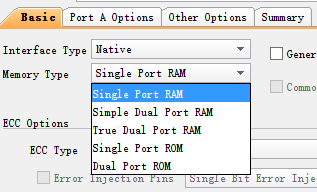
Block RAM可配置单端口RAM、伪双端口RAM、双端口RAM、单端口ROM、双端口ROM、FIFO。
各个模式调用时可承受的最高频率,参考pg058.pdf:
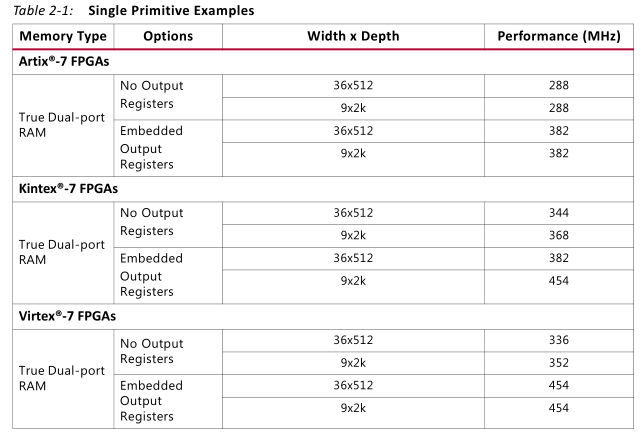
二、主要功能
学习资源: http://www.asic-world.com/examples/verilog/memories.html

A-RAM/ROM
主要功能:

每一个Block RAM都可配置为1个36Kb的BRAM或1个36Kb的FIFO;同时也可以将其配置为2个单独的18Kb的BRAM或1个18KbBRAM + 1个18Kb的BRAM。
为什么是18k而不是16k(2的整次幂)?因为每8bit一个校验位。2*8 + 2 =18bit。


结论:无论是单端口RAM、伪双端口RAM还是双端口RAM,他们都只有一块Memory。
Single-port RAM:
同步示例:
module ram_sp_sr_sw (
clk , // Clock Input
address , // Address Input
data , // Data bi-directional
cs , // Chip Select
we , // Write Enable/Read Enable
oe // Output Enable
); parameter DATA_WIDTH = 8 ;
parameter ADDR_WIDTH = 8 ;
parameter RAM_DEPTH = 1 << ADDR_WIDTH; //--------------Input Ports-----------------------
input clk ;
input [ADDR_WIDTH-1:0] address ;
input cs ;
input we ;
input oe ; //--------------Inout Ports-----------------------
inout [DATA_WIDTH-1:0] data ; //--------------Internal variables----------------
reg [DATA_WIDTH-1:0] data_out ;
reg [DATA_WIDTH-1:0] mem [0:RAM_DEPTH-1];
reg oe_r; //--------------Code Starts Here------------------ // Tri-State Buffer control
// output : When we = 0, oe = 1, cs = 1
assign data = (cs && oe && !we) ? data_out : 8'bz; // Memory Write Block
// Write Operation : When we = 1, cs = 1
always @ (posedge clk)
begin : MEM_WRITE
if ( cs && we ) begin
mem[address] = data;
end
end // Memory Read Block
// Read Operation : When we = 0, oe = 1, cs = 1
always @ (posedge clk)
begin : MEM_READ
if (cs && !we && oe) begin
data_out = mem[address];
oe_r = 1;
end else begin
oe_r = 0;
end
end endmodule // End of Module ram_sp_sr_sw
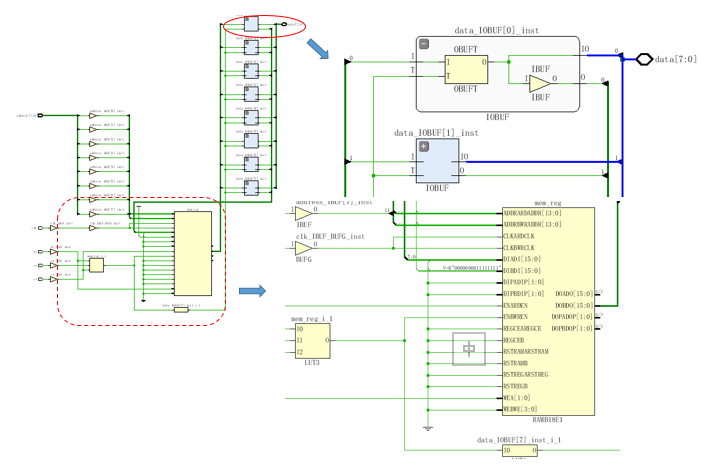
异步(异步读、同步写)示例:
module ram_sp_ar_sw (
clk , // Clock Input
address , // Address Input
data , // Data bi-directional
cs , // Chip Select
we , // Write Enable/Read Enable
oe // Output Enable
); parameter DATA_WIDTH = 8 ;
parameter ADDR_WIDTH = 8 ;
parameter RAM_DEPTH = 1 << ADDR_WIDTH; //--------------Input Ports-----------------------
input clk ;
input [ADDR_WIDTH-1:0] address ;
input cs ;
input we ;
input oe ; //--------------Inout Ports-----------------------
inout [DATA_WIDTH-1:0] data ; //--------------Internal variables----------------
reg [DATA_WIDTH-1:0] data_out ;
reg [DATA_WIDTH-1:0] mem [0:RAM_DEPTH-1]; //--------------Code Starts Here------------------ // Tri-State Buffer control
// output : When we = 0, oe = 1, cs = 1
assign data = (cs && oe && !we) ? data_out : 8'bz; // Memory Write Block
// Write Operation : When we = 1, cs = 1
always @ (posedge clk)
begin : MEM_WRITE
if ( cs && we ) begin
mem[address] = data;
end
end // Memory Read Block
// Read Operation : When we = 0, oe = 1, cs = 1
always @ (address or cs or we or oe)
begin : MEM_READ
if (cs && !we && oe) begin
data_out = mem[address];
end
end endmodule // End of Module ram_sp_ar_sw
对应电路:
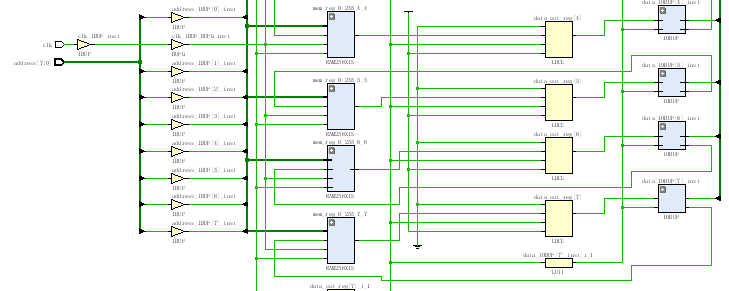
可以看出2^8 = 256由4个64拼接拼接而成:
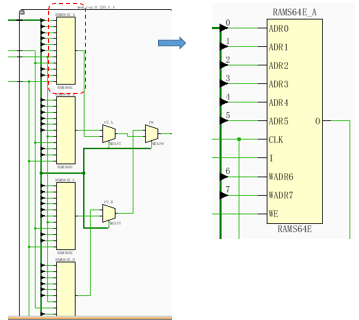
这里其实调用的是CLB中SliceM下的Distributed RAM资源:
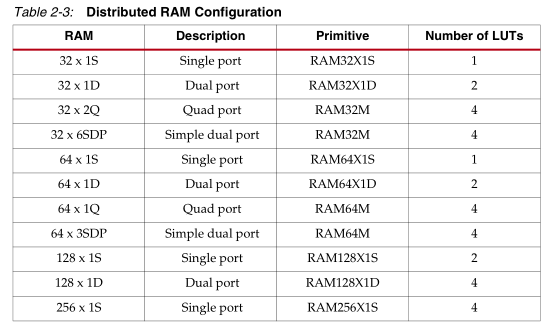
B-FIFO
FIFO的能力:

FIFO的IP核使用,具体可参考:pg057.pdf。
FIFO可调用shift reg、distributed RAM、Block RAM、BulitIn FIFO,关于使用,xilinx论坛有相关说法:
Q:
From PG057 (Fifo generator) I understand FIFO's can be implemented in 4 ways, using :
- block RAM
- distributed RAM
- shift register
- built-in FIFO (using FIFO18 / FIFO36)
is there any simple document / app note / overview describing on what basis you typically decide between the 4 implementations. What are the main tradeoffs, advantages, ... of each underlying memory type used?
I can imagine a few, but not sure if these are correct and complete :
- block RAM is interesting for large, deep fifo's
- distributed RAM is interesting for smaller fifo's
- shift register is interesting for smaller fifo's, with short word width
- built-in FIFO allow for the fastest fifo's
but that's just intuition ... so any corrections or further insights are welcome here!
A:
Its based your application , requirement and available resources in your target FPGA. The most of the points you mention correct. I would recommend you to refer target FPGA resource guide LUTs have lowest access time, FIFO18/FIFO36 good timing performance but require effort in design migration, BRAM very good for scalable memory requirement . You can also check about URAM/ultraram available in ultrascale devices
三、IP核调用
A-simple dual RAM
参考IP_bram笔记。
这里涉及到位宽的计算,以6通道,160MHz采样率,12bit有效位AD举例,现在需要转化为:240MHz的FPGA工作时钟。
12bit*6*160/240 = 48bit
位宽由12*6 = 72bit转化为48bit,:
- Port-A为写数据,width:位宽12*6 = 72bit,depth = 160
- Port-B为读数据,width:48bit,depth = 240
但Port-B的width只能是:72bit/(2^n),n = 0, ±1, ±2, ...,因此通常都是二次转化:
Step1:72*160 = 48*240 < x * 240,x = 72*2^n >48,此处n = 0;x工作在240MHz。
Step2:x * M = 48 * N,M、N都是整数。M = 1,N = 2,完成转化。
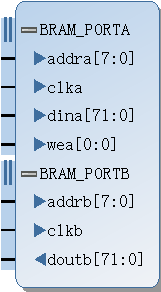
.png)

勾选primitive output register:

可见该选项延迟了1拍。
B-FIFO
主要参考:

关于IP核参数设置,可参考FIFO generator笔记。
与BRAM同样的例子,很多时候数据时钟域转换用dual-port RAM而不用FIFO,说是前者含地址,存在时延变量取数方便,但改为FIFO实现其实也可以,后者含有计数功能,同样可以进行定位。

从读使能给出,到数据输出,经过6个周期,计算:
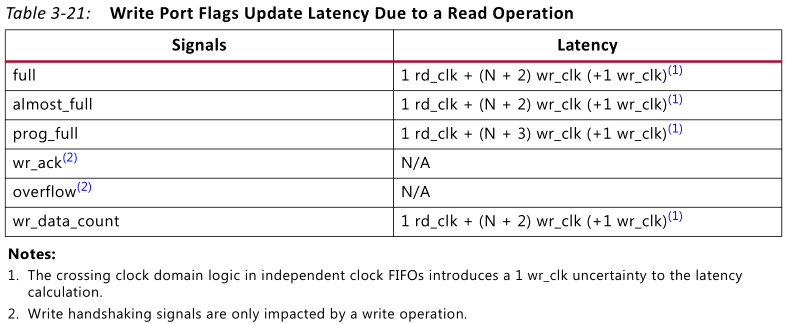
基础003_V7-Memory Resources的更多相关文章
- Understanding Virtual Memory
Understanding Virtual Memory by Norm Murray and Neil Horman Introduction Definitions The Life of a P ...
- DTrace to Troubleshoot Java Native Memory Problems
How to Use DTrace to Troubleshoot Java Native Memory Problems on Oracle Solaris 11 Hands-On Labs of ...
- Spring Boot Memory Performance
The Performance Zone is brought to you in partnership with New Relic. Quickly learn how to use Docke ...
- 再谈.net的堆和栈---.NET Memory Management Basics
.NET Memory Management Basics .NET memory management is designed so that the programmer is freed fro ...
- Allowing GPU memory growth
By default, TensorFlow maps nearly all of the GPU memory of all GPUs (subject to CUDA_VISIBLE_DEVICE ...
- CUDA ---- Memory Model
Memory kernel性能高低是不能单纯的从warp的执行上来解释的.比如之前博文涉及到的,将block的维度设置为warp大小的一半会导致load efficiency降低,这个问题无法用war ...
- Memory Leak Detection in C++
原文链接:http://www.linuxjournal.com/article/6556?page=0,0 An earlier article [“Memory Leak Detection in ...
- System and method for parallel execution of memory transactions using multiple memory models, including SSO, TSO, PSO and RMO
A data processor supports the use of multiple memory models by computer programs. At a device extern ...
- Move resources allocated using unmanaged interface to managed devm interface
转载:http://blog.csdn.net/swingboard/article/details/27207497 So today let’s talk about devm functio ...
- Find out when memory leaks are a concern and how to prevent them
Handling memory leaks in Java programs Find out when memory leaks are a concern and how to prevent t ...
随机推荐
- volatile synchronized AtomicInteger的区别
在网络上看了很多关于他们两个的区别与联系,今天用自己的话表述一下: synchronized 容易理解,给一个方法或者代码的一个区块加锁,那么需要注意的是,加锁的标志位默认是this对象,当然聪明的你 ...
- 再次编译 arm toolchains
为什么说再呢,因为已经好多次了.每次失败,都再从失败的地方开始.今天这篇呢,主要是记录今天的进展. 1. 编译要分三步走 之前学习的时候就有印象,要三步走.但是因为没有实践过,所以,忘差不多了.所谓三 ...
- 〖Android〗联想K860 logcat CM11.0出错信息及解决
错误1: D/gpsd ( ): main() D/gpsd ( ): argv[] = '/system/bin/glgps' D/gpsd ( ): argv[] = '-c' D/gpsd ( ...
- python模块之httplib(在py3中功能进一步强大,请详看文档)
# -*- coding: utf-8 -*-#python 27#xiaodeng#python模块之httplib(在py3中功能进一步强大,请详看文档) import httplib#是较为底层 ...
- python之实现ftp上传下载代码(含错误处理)
# -*- coding: utf-8 -*- #python 27 #xiaodeng #python之实现ftp上传下载代码(含错误处理) #http://www.cnblogs.com/kait ...
- HDFS分布式文件系统(The Hadoop Distributed File System)
The Hadoop Distributed File System (HDFS) is designed to store very large data sets reliably, and to ...
- Linux系统vi编辑器提示E325: ATTENTION的解决方法
非正常关闭文件会报这样的警告信息, 原因是系统产生了一个.swp的文件. 删除就行了.(前提是确认.swp文件没用了.) 例如: rm -f /etc/.shadowsocks.json.swp 详情 ...
- hql语句的case when then else end问题
http://www.iteye.com/problems/4499 hibernate count不支持case when?
- [转]expect实现ssh自动交互
shell脚本实现ssh自动登录远程服务器示例: #!/usr/bin/expect spawn ssh root@192.168.22.194 expect "*password:&quo ...
- 使用 WM_COPYDATA 在进程间共享数据
开发中有时需要进程间传递数据,比如对于只允许单实例运行的程序,当已有实例运行时,再次打开程序,可能需要向当前运行的实例传递信息进行特殊处理.对于传递少量数据的情况,最简单的就是用SendMessage ...
